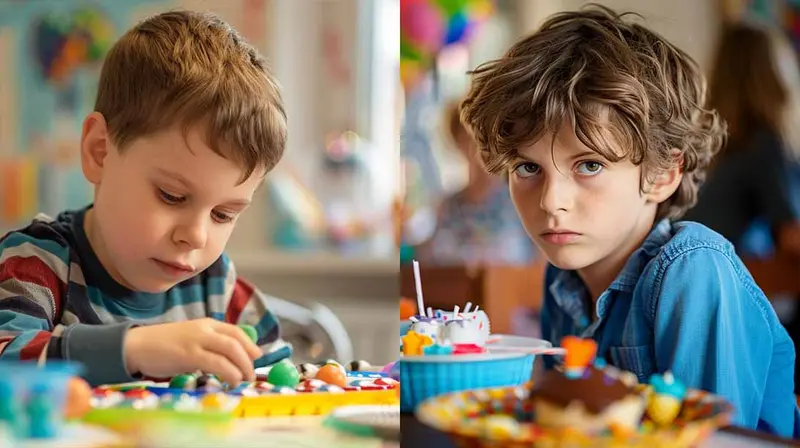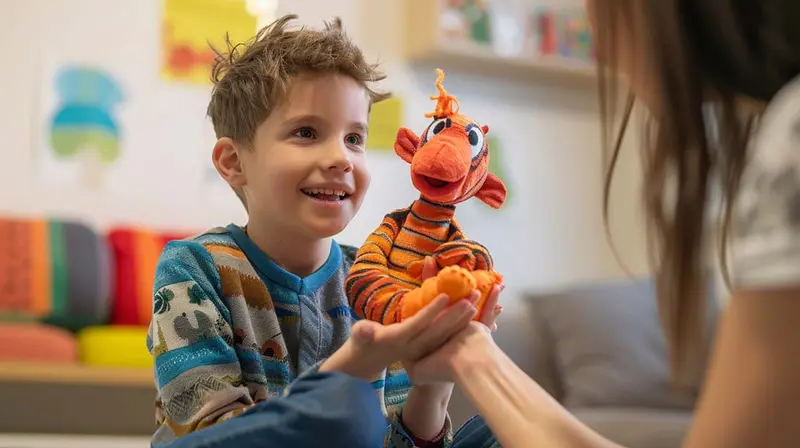Is your child talkative at home but silent in the classroom or at social events? They may be experiencing selective mutism, an anxiety-based communication disorder marked not by choice but by an overwhelming difficulty to speak in certain situations. This article is your guide to understanding the ‘why’ and ‘how’ of supporting children with selective mutism, as we explore its impact and outline strategies for encouragement and intervention.
Key Takeaways
- Selective mutism is a complex social anxiety disorder affecting children’s ability to speak in certain social situations, not related to shyness or stubbornness, and is often linked to an inherited tendency towards anxiety.
- Effective treatment of selective mutism involves behavioral and cognitive-behavioral therapies, potential use of medication, involvement of speech-language pathologists, and is tailored to the child’s unique challenges.
- Supporting children with selective mutism includes creating positive environments, encouraging social interaction, reinforcing successful speaking experiences, and collaborating with school staff for individualized support.
Selective Mutism: An Overview

Selective mutism is a social anxiety disorder where a child, who can speak perfectly well in some situations, remains silent in others. It’s a bit like that little niece we talked about earlier, chatty at home but silent at family gatherings. This condition affects about 1 in 140 young children, with higher prevalence observed in girls and in children who have migrated from their birth country. Weirdly enough, it often begins between the ages of 2 and 4, becoming noticeable once the child starts nursery or school.
Selective mutism is not just extreme shyness or a stubborn refusal to speak. It’s a complex blend of social anxiety, communication difficulties, and in some cases, speech and language issues. Research into selective mutism is shaping our understanding of this condition and helping us discover new ways to treat a selectively mute child.
Now, you might be thinking, “But what causes selective mutism?” Well, like many mental health disorders, the exact cause is not known. However, it is believed that children with selective mutism have an inherited tendency to anxiety, and some may have a more reserved, cautious, or restrained personality.
It’s not just the inability to speak that sets children with selective mutism apart. It’s a complex disorder that can impact every aspect of a child’s life, from their performance at school to their relationships with friends and family. But remember, with the right support and understanding, children with selective mutism can overcome their fears and lead fulfilling lives.
Anxiety Disorders and Selective Mutism

To understand selective mutism, it’s crucial to examine its relationship with other anxiety disorders. Selective mutism is classified as a type of anxiety disorder, which means it shares some common features with other disorders in this category.
One of the most closely related psychiatric disorders is social anxiety disorder, also known as social phobia. Interestingly, there’s a robust and statistically significant correlation between social anxiety and symptoms of selective mutism. This means that children with selective mutism often experience intense fear in social situations, just like individuals with social anxiety disorder. So, it’s not that they don’t want to speak, they’re too afraid to.
The connection between selective mutism and anxiety disorders goes beyond shared social anxiety symptoms. Both conditions can result from an overactive fear response in the brain. When faced with specific social situations, individuals with these disorders may freeze, flee, or even fight, all due to an increased sense of fear.
Understanding the link between selective mutism and other anxiety disorders is essential in creating effective treatment plans. Selective mutism anxiety research helps us see that selective mutism isn’t just about refusing to speak; it’s about struggling with intense fear and anxiety in social situations.
Differentiating Selective Mutism from Other Disorders

Now, let’s clear up a common misconception. Many people confuse selective mutism with autism spectrum disorder. While both conditions can impact communication, they are distinct disorders. A child can have selective mutism without being on the autism spectrum.
That being said, selective mutism and autism can share some overlapping features. For example, both disorders can present challenges with social communication and interaction. Children with selective mutism may face sensory processing challenges, like being overwhelmed in busy environments. This is different from the characteristics normally attributed to autism, but it does show how complex and varied these conditions can be.
So, while it’s important to understand the differences between selective mutism and other disorders, it’s equally important to recognize the potential areas of overlap. This can help ensure that children receive the right diagnosis and the most effective treatment.
Identifying Signs and Symptoms

Identifying selective mutism can be challenging. Why? Because it’s not just about whether a child speaks or not, but where, when, and how they choose to communicate.
Physical symptoms can also accompany selective mutism. You may notice your child experiencing nausea or headaches, or signs of severe anxiety such as tension, clinginess, or aggression after interactions. These symptoms can provide important clues to understanding why a child might be struggling to speak in certain situations.
Children with selective mutism can also exhibit varying speech patterns. Some may:
- be completely silent in certain social contexts
- whisper or speak only to certain people
- rely on nonverbal communication, like nodding or shaking their heads
- avoid all forms of communication, including gestures or writing.
Finally, pay attention to your child’s body language. Children with selective mutism often lack facial expressions and have difficulty making eye contact. These subtle signs can often be overlooked but play a crucial role in identifying this condition.
Inhibited Temperament
One of the factors contributing to the development of selective mutism is inhibited temperament. Children with this type of temperament are often described as “slow to warm up”, meaning they are typically cautious, shy, and need time to adjust to new situations.
Children with severely inhibited temperaments, such as an anxious child, may exhibit early signs of anxiety, such as separation anxiety and extreme shyness. These early manifestations of anxiety can contribute to the development of childhood anxiety disorders, including separation anxiety disorder and selective mutism later on.
It’s also worth noting that children with inhibited temperaments often have a lower threshold for excitability in the amygdala, a part of the brain that plays a key role in processing emotions. This can amplify their susceptibility to anxiety in social situations such as school or family gatherings.
The Role of Family Members
Family members play a critical role in identifying and managing selective mutism. They are often the first to notice atypical behavior in different settings, such as the child being talkative at home but silent at school.
As a family member, understanding the signs and symptoms of selective mutism is key. It can help you provide the right support, encourage treatments, and most importantly, help your child feel understood and accepted.
Treatment Approaches for Selective Mutism

So, how do we treat selective mutism? The cornerstone of treatment for children with this condition is behavioral and cognitive-behavioral therapies. These therapies aim to gradually reduce the anxiety associated with speaking.
Several therapeutic methods have proven to be effective. These include:
- Defocused Communication – This approach involves shifting the focus away from the child’s speaking, thereby reducing the pressure to talk. It uses techniques such as parallel play, where the therapist engages in an activity alongside the child without expecting them to speak, gradually helping them to feel more comfortable and eventually initiate communication themselves.
- Parent Child Interaction Therapy for Selective Mutism (PCIT-SM) – A specialized adaptation of the evidence-based PCIT, this method emphasizes the role of parents as agents of therapeutic change. It involves coaching parents to effectively manage their child’s anxiety and encourage speech through play-based interactions and positive reinforcement.
- Social Communication Anxiety Treatment (S-CAT) – Developed specifically for selective mutism, S-CAT focuses on reducing social communication anxiety through real-life practice and exposure. The child is gradually introduced to speaking in social settings, starting with nonverbal communication and slowly progressing to verbal interactions.
- The Ritual Sound Approach – This unique technique helps children with selective mutism overcome their fear of speaking by starting with non-threatening sounds or words that are part of a ritual or game. As the child becomes more comfortable with these sounds, they are encouraged to expand their vocalizations into words and eventually into more spontaneous speech.
- Integrated Behavior Therapy – This comprehensive approach combines various techniques, including behavioral interventions, cognitive-behavioral therapy, and family involvement, to address the multifaceted nature of selective mutism. It aims to improve the child’s ability to speak in social settings while also working on underlying anxiety and communication skills.
Each of these methods aims to improve speech and reduce anxiety in children with selective mutism.
In some cases, medication may also be used to enhance treatment outcomes. Selective serotonin reuptake inhibitors, a type of antidepressant, have been shown to be effective when used alongside behavioral or cognitive-behavioral therapies.
Additionally, Speech-Language Pathologists can play a pivotal role in treatment. They utilize techniques such as augmented self-modeling and provide practice to reinforce successful speaking experiences in social situations.
Overall, the treatment approach for selective mutism is multifaceted and individualized, taking into account the child’s unique needs and challenges. It’s a team effort involving therapists, teachers, and family members, all working together to support the child.
Early Intervention and Language Development
Early intervention is significantly linked to better outcomes in language development for children with selective mutism. The earlier the condition is identified and treated, the better the chances for the child to develop effective communication skills.
Families play a vital role in early recognition of this condition. They are often the first to notice the signs and can seek help promptly, paving the way for early intervention.
Interestingly, selective mutism can also occur in bilingual children. It often presents among those who speak multiple languages, although being bilingual is not a cause of selective mutism. However, it does appear more commonly in multilingual environments.
This underscores the complexity of selective mutism and the importance of early recognition and intervention. The sooner we identify and address these challenges, the better equipped we will be to help children develop their language skills and overcome selective mutism.
Collaborating with School Staff
Collaboration is key in addressing selective mutism, especially in school settings. Forming a team consisting of teachers, parents, and therapists is crucial for the effective treatment of this condition.
Teachers need to be informed about the child’s specific dos and don’ts to foster a supportive speech environment. For instance, forcing a child with selective mutism to speak in front of the class may increase their anxiety and further inhibit their ability to speak.
Small group discussions and pairing students with those they feel comfortable around can be effective strategies. Not only can these efforts encourage speech in the classroom, they can also help children feel more comfortable and less anxious in school.
Strategies for Supporting Children with Selective Mutism

Supporting children with selective mutism goes beyond treatment. It involves creating a positive environment, encouraging social interaction, and reinforcing successful speaking experiences. Let’s dive into some of the key strategies.
Creating a positive and encouraging classroom atmosphere can make students with selective mutism feel comfortable and more likely to participate verbally. Teachers can facilitate participation through nonverbal communication, pairing children with buddies, and organizing small group activities.
Introducing children with selective mutism to small group gatherings can help them manage anxieties about speaking in larger groups. Games with a verbal component can be a fun way to encourage communication. Allowing warm-up time in new social settings can also prepare children for communication on their own terms.
Finally, implementing strategies at home that encourage speaking can also foster more communication. This should be supported by love, praise, and a whole lot of patience. Remember, it’s about progress, not perfection.
Reinforcing Successful Speaking Experiences
Reinforcing successful speaking experiences is a key strategy in supporting a child with selective mutism. This involves encouraging speaking and then rewarding successful speaking experiences with praise and small incentives.
Non-interruptive praise can strengthen positive speaking behavior. This means subtly acknowledging when the child voluntarily communicates, rather than interrupting or making a big fuss.
Brave talking exercises can also be beneficial. These activities present an opportunity for the child to practice simple communication scripts, bolstering their skills in a controlled setting. But remember, it’s important to avoid offering rewards for speaking in specific situations as this can be counterproductive.
Encouraging Social Interaction and Bravery Practices
Gradually exposing children to anxiety-inducing situations can help reduce anxiety and encourage social interaction. Here are some steps to follow:
- Start small, like having a playdate with one friend.
- Once the child feels comfortable, move on to larger gatherings.
- Allow the child to build confidence at their own pace.
By following these steps, you can help your child overcome anxiety and improve their social skills.
For children who are unable to speak, alternative methods of communication can be a lifeline. This could include writing, using gestures, or visual aids. These methods can facilitate their participation in social interactions without the pressure to speak.
Education is also a powerful tool. Teaching classmates about selective mutism can foster understanding and create an inclusive environment. This can help children with selective mutism feel less isolated and encourage social interaction.
Navigating School Environment and Challenges

Navigating elementary school can be particularly challenging for children with selective mutism, especially when a child enters elementary school. It’s the most common place where the condition interrupts a child’s daily life, particularly at the beginning of the school year.
Parents can address speaking difficulties in school assignments by requesting adaptations in the Individualized Education Plan (IEP) or informing teachers about speaking issues ahead of time. This proactive approach can make a significant difference in helping children manage their anxiety and participate more fully in school activities.
The school environment, with its various social situations and expectations, can be overwhelming for a child with selective mutism. But with the right support and understanding, these challenges can be navigated, and the child can thrive.
Individualized Education Plan (IEP)
An Individualized Education Plan (IEP) is essential for students with selective mutism. It provides specialized instruction and support services necessary for their success in school.
When developing IEP goals, it’s important to focus on specific communication difficulties and social-emotional challenges unique to the student. These goals might include:
- Increasing verbal communication in structured settings
- Developing coping strategies for anxiety in social situations
- Improving social interactions and peer relationships
Regular monitoring and evaluation of IEP goals are necessary to ensure the effectiveness of interventions and strategies. This allows for adjustments to be made as needed, ensuring that each child receives the support they need to succeed.
Adapting Classroom Activities and Assignments
Teachers hold a significant role in supporting children with selective mutism. They can adapt classroom activities and assignments to better suit the child’s needs. For instance, accepting nonverbal responses while slowly shifting towards encouraging verbal interactions can be a beneficial approach.
Providing specific praise for communication efforts also plays a key role in treating children with selective mutism. This can motivate them to interact with their peers without the fear of criticism or ridicule.
Other effective adaptations can include using video recordings for presentations or creating small group activities. These strategies can help children share their thoughts without the pressure of speaking in large group settings, thereby building their confidence in classroom settings.
Summary
We’ve covered a lot of ground in this blog post, from understanding what selective mutism is, its link to anxiety disorders, the role of family members, and various treatment approaches, to strategies for supporting children with selective mutism and navigating school challenges.
Remember, selective mutism is more than just a child refusing to speak. It’s a complex condition that requires understanding, patience, and support from everyone involved. With the right intervention and support, children with selective mutism can overcome their fears and lead fulfilling lives.
Frequently Asked Questions
Can a child overcome selective mutism?
Yes, with appropriate handling and treatment, most children are able to overcome selective mutism, but the older they are when diagnosed, the longer it will take.
What kind of trauma causes selective mutism?
Traumatic experiences, such as witnessing a shooting or experiencing relationship abuse, can contribute to selective mutism in adulthood. This happens due to the impact of the trauma on the individual's ability to communicate effectively.
What is selective mutism?
Selective mutism is a social anxiety disorder that causes a child to remain silent in certain situations despite being able to speak in others. It's important to seek professional help if you suspect a child may have selective mutism.
How is selective mutism different from autism?
Selective mutism and autism are distinct disorders, even though both can impact communication. A child can have selective mutism without being on the autism spectrum.
How can we treat selective mutism?
You can treat selective mutism with behavioral and cognitive-behavioral therapies, speech-language therapy, and sometimes medication. These strategies can help individuals overcome their challenges and improve communication.
